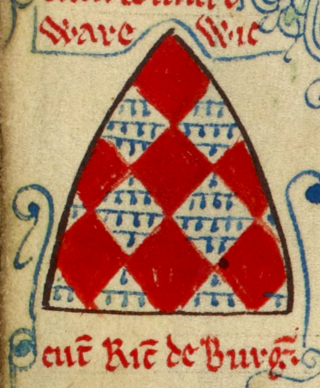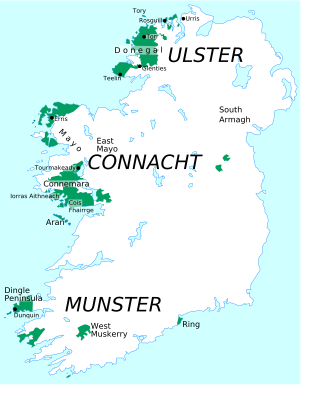This article includes a list of references, related reading, or external links, but its sources remain unclear because it lacks inline citations .(August 2022) |
The Ciarraige were a population-group recorded in the early historic era in Ireland.
This article includes a list of references, related reading, or external links, but its sources remain unclear because it lacks inline citations .(August 2022) |
The Ciarraige were a population-group recorded in the early historic era in Ireland.
The word Ciarraige means the people of Ciar. Ciar was the illegitimate son of Fergus, the King of Ulster. After being banished from the Court of Cruachan, Ciar sought refuge in Munster. There he gained the territory for the first branch of Ciarraige, which he called Ciarraige Luachra. [1]
The Cíarraige were a people found scattered over much of Ireland. Known branches were:

Richard Mór de Burgh, 1st Lord of Connacht, was an Anglo-Norman aristocrat who was Seneschal of Munster and Justiciar of Ireland (1228–32).
Toirdhealbhach ua Briain, anglicised Turlough O'Brien, was King of Munster and effectively High King of Ireland. A grandson of Brian Bóruma, Toirdelbach was the son of Tadc mac Briain who was killed in 1023 by his half-brother Donnchad mac Briain.

The Conmaicne were a people of early Ireland, perhaps related to the Laigin, who dispersed to various parts of Ireland. They settled in Connacht and Longford, giving their name to several Conmaicne territories. T. F. O'Rahilly's assertion the Conmaicne were non-Goidelic is not widely accepted.

Munster Irish is the dialect of the Irish language spoken in the province of Munster. Gaeltacht regions in Munster are found in the Gaeltachtaí of the Dingle Peninsula in west County Kerry, in the Iveragh Peninsula in south Kerry, in Cape Clear Island off the coast of west County Cork, in Muskerry West; Cúil Aodha, Ballingeary, Ballyvourney, Kilnamartyra, and Renaree of central County Cork; and in an Rinn and an Sean Phobal in Gaeltacht na nDéise in west County Waterford.
Murchadh Riabhach Ó Cuindlis was an Irish scribe of the Ó Cuindlis family of brehons and scholars. Other renderings of his name have Muircheartach or Murchad, and sometimes Ó Cuinnlis.
Kerry or Kerri is a unisex English language given name of Gaelic (Irish) origin.
Nollaig Ó Muraíle is an Irish scholar. He published an acclaimed edition of Dubhaltach Mac Fhirbhisigh's Leabhar na nGenealach in 2004. He was admitted to the Royal Irish Academy in 2009.
The 1998 Bank of Ireland All-Ireland Senior Football Championship was the 112th edition of the GAA's premier Gaelic football competition. The championship began on 3 May 1998 and ended on 27 September 1998.
The 2002 All-Ireland Senior Football Championship was the 116th staging of the All-Ireland Senior Football Championship, the Gaelic Athletic Association's premier inter-county Gaelic football tournament. The championship began on 5 May 2002 and ended on 22 September 2002.
Iarmhumhain was a Kingdom in the early Christian period of Ireland in west Munster. Its ruling dynasty was related to the main ruling dynasty of Munster known as the Eóganachta. Its ruling branch was called the Eóganacht Locha Léin or Ui Chairpri Lúachra. Their center was around Killarney, County Kerry at Loch Léin. The name Iarluachair means west of the Sliabh Luachra mountains.
The 1965 All-Ireland Senior Football Championship was the 79th staging of the All-Ireland Senior Football Championship, the Gaelic Athletic Association's premier inter-county Gaelic football tournament. The championship began on 2 May 1965 and ended on 26 September 1965.
The Mairtine were an important people of late prehistoric Munster, Ireland who by early historical times appear to have completely vanished from the Irish political landscape. They are notable for their former capital, Medón Mairtine, becoming the chief church of the later Eóganachta, namely Emly.
Tadhg Ó Cellaigh, also known as Tadhg mac Domnall O Cellaigh was King of Uí Maine and Chief of the Name.
Mael Brigte mac Mothlachain, assassin, fl. 649.
The Cálraighe were a population-group found mostly in northern Connacht as well as County Westmeath and County Longford. They were purported descendants of Lugaid Cal, son of Daire Sirchrechtaig, who was himself a supposed descendant of Lugaid mac Itha, a first cousin of Míl Espáine.
The Ciarraighe Locha na nÁirne were a branch of the Ciarraighe people, located in what is now central-east County Mayo in Connacht.
The Ciarraige Óic Bethra were a population-group found in early medieval Ireland.
The Ciarraige Aí were a population-group found in medieval Ireland.
The Ciarraige Airtech were a population-group found in medieval Ireland.
Sir Thomas Lestrange, also Le Strange, Le Straunge, or Strange, was an English official in the Presidency of Connaught and landowner during the Tudor conquest of Ireland. He was one of the seven sons of Sir Thomas Le Strange of Hunstanton in Norfolk and Anne Vaux, daughter of Nicholas Vaux, 1st Baron Vaux of Harrowden, and like his brothers Nicholas and Richard, the younger Thomas went to Ireland. By 1557 he was sub-constable of Athlone Castle and in 1559 became sheriff of Westmeath. In 1565 he gained two crown leases in County Westmeath: one of 21 years for the lands of the dissolved abbey of Lough Sewdy, the other of 37 years for lands of the attainted Sir Oliver FitzGerald. He used his official positions to acquire lands in counties Galway, Roscommon, and Longford, and at his death owned "30 quarters of land in the territory of Clankerno" [Clann Ceithearnaigh, or Ciarraige Aí]. Lestrange had a castle called Castlereogh near Athleague, in what is now the townland of Castlestrange in the civil parish of Fuerty, County Roscommon.
{{cite book}}: CS1 maint: location missing publisher (link){{cite book}}: CS1 maint: location missing publisher (link)[ ISBN missing ]{{cite book}}: CS1 maint: location missing publisher (link)[ ISBN missing ]